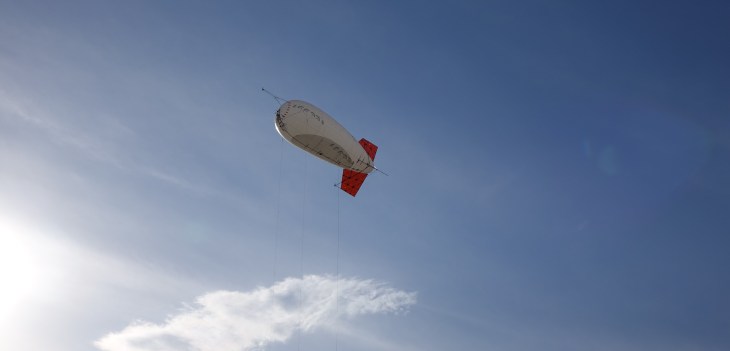Altaeros, a Boston-based startup that develops autonomous aerostats, announced today that it has received $7.5 million in new funding from SoftBank Group. The capital will speed up the launch of SuperTower, a project that uses Altaeros’ tethered balloons (pictured above) to bring broadband wireless to rural areas.
This is the second time SoftBank has funded Altaeros. Its first investment of $7 million in 2014 was used for the development of Altaeros’ airborne wind turbines to provide renewable energy. Altaeros, whose other investors include Mitsubishi Heavy Industries and RNT Associates (Indian industrialist Ratan Tata’s investment vehicle), has now raised a total of about $20 million.
SoftBank’s interest in Altaeros is understandable: not only is cleantech one of its investment focuses, but it also holds a majority stake in Sprint and SuperTower may give the telecom (and its competitors) new opportunities.
Launched in 2010 at MIT, Altaeros’ team anticipated from the beginning that its aerostats can be used for many commercial applications, says co-founder Adam Rein. Over the last two years, the startup has focused on developing SuperTower to answer increased demand for cost-effective broadband infrastructure that can cover rural areas and bring Internet to the four billion people who still don’t have access.
The SuperTower is a tethered aerostat that floats 800 feet above ground. Altaeros says it enables telecoms to expand their LTE (and future 5G) networks to rural areas at “up to 70% lower cost, in half the time and with significantly lower energy” than conventional towers. SuperTower can be deployed for permanent or temporary use, like during an emergency.
An obvious question is what advantages does SuperTower offer over Google’s Project Loon and Facebook Aquila, which use high-altitude balloons and solar-powered planes, respectively, to provide low-cost broadband coverage?
Rein says SuperTower’s key difference is that it integrates easily into existing networks. “From the carrier’s perspective, the SuperTower is just another tower type. It uses the same radios and antennas and permitting frameworks, and it provides last-mile connectivity to the end users in exactly the same way,” he explains. SuperTower is less expensive to deploy, however, and covers a much larger area. Rein claims that one SuperTower can provide coverage equivalent to 30 conventional towers.
Unlike Project Loon or Facebook Aquila, SuperTower aerostats remain fixed to the ground with conductive tethers, which also provide electricity for high-capacity radio. This means SuperTower can handle large numbers of people engaging in high-bandwidth activities, like streaming videos.
Project Loon and SuperTower both provide last-mile connectivity, but Project Loon uses solar panels and batteries. This limits how much capacity it can handle, but Rein says this also means it is suited for use in very rural areas where there are a few users spread out over wide distances. But Facebook Aquila, as well as OneWeb satellites, can complement SuperTower because they provide middle-mile connectivity, while SuperTower is meant for the last mile. Combined, the systems can reduce costs and speed up access to the Internet.
Altaeros is exploring other uses for its balloons, which it bills as the “only full-scale autonomous aerostat solution in the world.”
“Traditional aerostats are surprisingly labor-intensive to operate. They require large crews to manually handle the lines whenever they want to launch or recover a system,” Rein says. “The cost of keeping this crew on call has limited aerostats to mostly defense and government applications.”
The aerostats are designed to be used for different durations, but Altaeros generally targets a deployment time of one to two months. After that, the aerostats are brought down, refilled and launched again, a process that takes less than an hour. They don’t need a full-time ground crew, which means more sectors can use them. Aside from telecommunications and renewable energy, Altaeros’ technology can also be helpful for disaster relief and agricultural and environmental monitoring.
“We will aim to develop as many services as we can for the network that we deploy,” says Rein. “At the end of the day, an autonomous aerostat is a platform and its potential applications are only limited by the creativity of our customers.”
